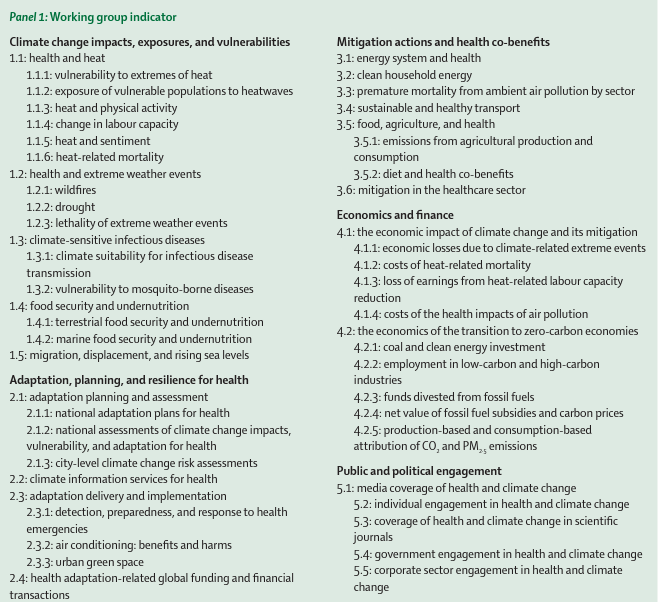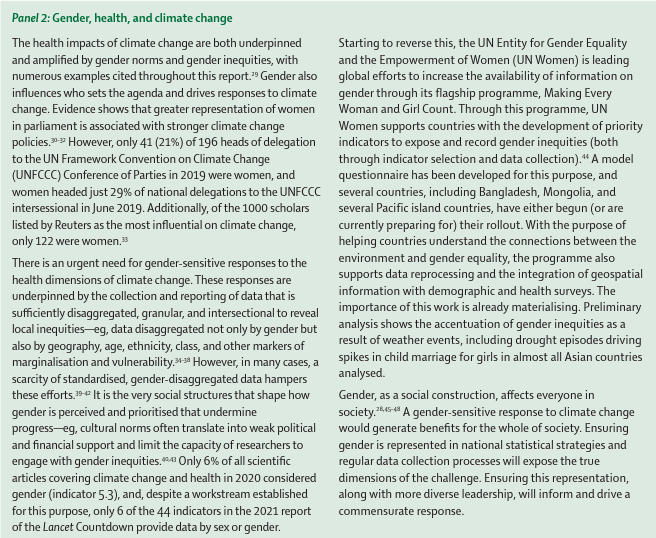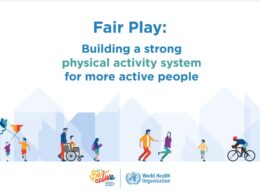This is an excerpt of the paper below, focused on the introduction of the report.
The 2021 report of the Lancet Countdown on health and climate change: code red for a healthy future
The Lancet
Marina Romanello, PhD; Alice McGushin, MSc; Claudia Di Napoli, PhD; Paul Drummond, MSc; Nick Hughes, PhD; Louis Jamart, MSc; et al.
Published:October 20, 2021
The COVID-19 pandemic has changed societies in previously unimaginable ways, with deepening and widespread concerns about global health security, inequities, and anthropogenic influences on the environment.
- As of May 11, 2021, the pandemic has resulted in almost 191 million cases and 4·1 million deaths, 1 , 2 and its multidimensional impacts on health and wellbeing, together with its disruption to work, social, and leisure activities, still continue.
- The overwhelming demand for health care caused 94 of the 105 countries examined to have disruptions to the delivery of essential health services, undermining health and wellbeing. 3
- COVID-19 led to a worldwide economic recession;
- pandemic-induced borrowing by the World Trade Organization’s so-called developing countries amounted to US$130 billion by July, 2020. 6
As of May 11, 2021, the pandemic has resulted in … (1) 4·1 million deaths; (2) disruptions to the delivery of essential health services; (3) led to a worldwide economic recession; (4) 90 million people were pushed below the extreme poverty threshold in 2020, (5) a pandemic-induced borrowing of US$130 billion by July, 2020.
While the world’s attention has been diverted towards the ongoing acute health crisis, the health effects of human-induced climate change continue to increase.
- Climate change contributed to the unusually high temperatures seen during 2020 in the UK and Siberia;
- the record-breaking heatwave that affected populations across the Pacific Northwest areas of the USA and Canada in June, 2021, which caused more than 1000 deaths (a number expected to increase);
- accelerated glacier retreat that is putting the Huaraz (Peru) under imminent flooding risk; and
- During a 6 month period in 2020, 84 disasters from floods, droughts, and storms affected 51·6 million people in countries already struggling with COVID-19, 12 with the escalating impacts of disasters reducing their ability to respond to health emergencies.
- Additionally, climate impacts might undermine the capacity of countries to repay their debts, hindering their progress towards the Sustainable Development Goals (SDGs). 13 , 14
While the world’s attention has been diverted towards the ongoing acute health crisis, the health effects of human-induced climate change continue to increase.
As with COVID-19, the health impacts of climate change are inequitable, with disproportionate effects on the most susceptible populations in every society, including people with low incomes, members of minority groups, women, children, older adults, people with chronic diseases and disabilities, and outdoor workers. 15
Relationships between climate change and COVID-19 provide ongoing evidence of the interconnectedness of the world and the health consequences of inequities.
This report depicts the synergies and interactions between these two crises.
- The world is now 1·2°C warmer than in the pre-industrial period (1850–1900), the past 7 years have been the hottest 7 years on record, and 2020 tied with 2016 as the hottest year yet. 16 , 17 , 18
- Atmospheric CO2 concentrations have reached a concerning milestone and are now 50% higher than in the pre-industrial era. 19
- Changes, such as reduced soil moisture, could limit the Earth’s carbon reuptake, resulting in increased CO2 concentrations in the atmosphere. 20
The world is now 1·2°C warmer than in the pre-industrial period (1850–1900), the past 7 years have been the hottest 7 years on record, and 2020 tied with 2016 as the hottest year yet.
- Furthermore, some critical tipping points are close or might have been surpassed, which could destabilise the Earth’s climate system. 21 , 22
- Although the large reductions in transport use and industrial manufacturing during the pandemic resulted in energy-related emissions for 2020 falling by 5·8% (the largest annual percentage decline since World War 2), this reduction was short-lived and emissions have risen in 2021. 23 , 24 , 25
Without an adequate response, the health effects of climate change will worsen throughout the coming decades.
The world now turns with hope to the 2021 UN Framework Convention on Climate Change (UNFCCC) conference in Glasgow (UN Climate Change 26th Conference of Parties; COP26), originally scheduled for 2020.
Over the past year, the world has seen more ambitious climate targets from governments and businesses than before and 73% of current global emissions are now covered by emissions targets of net zero announced in May, 2021.
Nevertheless, these announcements are non-binding, and, even with their full implementation, the world would be on track for a warming of roughly 2·4°C (1·9–3·0°C) since pre-industrial times by 2100. 26
These climate announcements are being made against the backdrop of huge investments in economic recovery from COVID-19.
Depending on their consistency with climate targets, these investments could take the world in one of two directions
- either directing the world towards the goals of the Paris Agreement or
- locking it into increased emissions and climate change that will damage the health of current and future generations.
As humanity faces a crucial turning point, the indicators in this report provide the health evidence to inform a global response to the impacts of climate change and to identify the considerable health, environmental, and economic benefits that would result if a so-called green recovery from COVID-19 was prioritised.
Sixth annual report tracking progress on health and climate change
The Lancet Countdown is an independent, international, and multidisciplinary collaboration that monitors the health impacts of climate change, and the progress, or absence of, in the world’s response.
The Lancet Countdown draws on the expertise of climate scientists, economists, energy and transport experts, social and political scientists, public health experts and health professionals, and others, spanning 43 academic and UN institutions.
Together, these contributors report on 44 indicators that are organised in five domains:
- climate change impacts, exposures, and vulnerabilities;
- adaptation, planning, and resilience for health;
- mitigation actions and health co-benefits;
- economics and finance; and
- public and political engagement.
The Lancet Countdown’s indicator domains were selected through an open, global consultation process that identified scientifically documented links between health and climate change, with indicators developed according to well-established methods and the availability of reliable and regularly updated data with adequate geographical and temporal scales. 27
Each year, the indicators have been improved through an open, iterative, and adaptive approach, and new indicators have been introduced to provide an increasingly complete picture of the health dimensions of climate change.
For the 2020 and 2021 reports, all new indicators underwent an independent assessment process led by world experts before the formal peer review, adding rigour and transparency to the collaboration’s research.
Existing indicators are undergoing a similar, independent quality improvement process, aimed at ensuring they continue to use the best available data and methods.
Three new indicators are added to the 2021 report:
- incorporating considerations of mental wellbeing by tracking the effect of heat on expressed online sentiment;
- capturing the influence of heat on safe physical activity; and
- tracking consumption-based greenhouse gas and fine particle matter (PM2·5) emissions.
Most of the pre-existing indicators underwent major improvements, with strengthened methods, datasets, and metrics and expanded geographical and temporal coverage.
All indicators, including their methods, data sources, caveats, and plans for future improvements, are described in detail in appendix 5 (an essential manual for this report).
The indicators for the 2021 report are listed in panel 1.

Each indicator, wherever possible and appropriate, is disaggregated into very high, high, medium, and low human development index (HDI) country groups, as defined by the UNDP, in the latest year that data were available (2019). 28
This composite HDI captures three dimensions:
- a long and healthy life (with life expectancy as a proxy),
- education (captured by the mean of years of schooling), and
- standard of living (measured by per-capita gross national income). 28
In line with the priorities of The Lancet’s Diversity Board, gender disparities are also considered wherever relevant. However, a scarcity of gender-disaggregated data means that few indicators can capture these differences quantitatively and often do so using sex disaggregation as a proxy for gender (see panel 2).

The COVID-19 pandemic will alter the trends of many of the indicators reported; some of these trends can be identified in this report and others will become apparent in the coming years.
COVID-19 has also altered population demographics, mortality rates, and the structure and size of the labour force. These changes are not reflected in the current indicators, presenting methodological challenges in the assessment of the health impacts of climate change.
How the COVID-19 pandemic affects the methods and assumptions of the Lancet Countdown’s indicators will become clearer in future reports as more data will be available.
The global reach of the Lancet Countdown is expanding.
Two regional offices, one in South America (Universidad Peruana Cayetano Heredia, Lima, Peru) and one in Asia (Tsinghua University, Beijing, China), were established in 2020 and an office in Europe was established in 2021 (Barcelona Supercomputing Centre, Barcelona, Spain).
These regional collaborators contributed indicators to the 2021 report and are working on nationally-relevant and regionally-relevant health and climate change research, accompanied by local communications and policy engagement.
A third regional office, based at the University of the West Indies (Kingston, Jamaica), was established in September, 2021, and aims to build on the network and evidence base of health and climate change in small island developing states (SIDS).
The Lancet Countdown is also working in collaboration with the European Environment Agency, incorporating policy-relevant data from its indicators into the European Climate and Health Observatory.
National and regional reports were published for Australia (in partnership with the Medical Journal of Australia), China, and SIDS. 49 , 50 , 51
For the third year, the data underpinning each of the Lancet Countdown’s indicators have been shared through an online data visualisation platform, where they can be explored at finer spatial and temporal scales.
The work of this collaboration is driven by the ongoing support from The Lancet and the Wellcome Trust, the Lancet Countdown’s scientific advisory group and higher-level advisory board, and, importantly, the Lancet Countdown’s authors and collaborators.
The collaboration welcomes offers of support from new experts and new institutions willing to build on this analysis as the Lancet Countdown monitors the world’s response to the health effects of climate change during this decade.
For the complete version of the report, refer to the original publication.
For summary reasons, we jump now to the Conclusions of the report.
Conclusion: the 2021 report of the Lancet Countdown
The 2021 report of the Lancet Countdown finds a world overwhelmed by an ongoing global health crisis, which has made little progress to protect its population from the simultaneously aggravated health impacts of climate change.
The inequities of these impacts and the response, including those of gender, are brought into sharp focus within each of the indicators presented.
This exposes the urgent need for the collection of standardised data to capture inequities and vulnerabilities (panel 2).
Climate-sensitive infectious diseases are of increasing global concern and the environmental suitability for the transmission of all infectious diseases is increasing (indicator 1.3.1).
- For non-cholerae Vibrio bacteria, the environmental suitability for transmission in northern latitudes has increased by 56% since the 1980s.
- The number of months suitable for malaria transmission has increased by 39% in highland areas of the low HDI country group and,
- during the past 5 years, the environmental suitability for the transmission of emerging arboviruses (eg, dengue, chikungunya, and Zika) was between 7% and 13% higher than it was in the 1950s.
The high temperatures in 2020, a year that tied with 2016 as the hottest year on record, resulted in extreme heat-related health impacts, affecting the emotional and physical wellbeing of populations around the world (indicators 1.1.1–1.1.6).
These higher temperatures and altered weather patterns are also leading to more frequent extreme weather events and increased wildfire exposure (indicators 1.2.1, 1.2.2, and 1.2.3) and are putting years of progress on food and water security at risk in many parts of the world.
The 5 years with the greatest area of the world’s surface affected by droughts have all occurred between 2015 and 2020 (indicator 1.2.2),
- the yield potential of all major staple crops continues to fall as a result of the rising temperatures (indicator 1.4.1), and
- 79% of all potential work hours lost to extreme heat in low HDI countries occurred in the agricultural sector in 2020 (indicator 1.1.4).
However, measures to curb emissions have been grossly inadequate.
Emissions are declining too slowly or heading in the wrong direction in the highest emitting sectors (indicators 3.1, 3.4, and 3.5.1).
This delay in progress is contributing to millions of deaths each year due to exposure to indoor and ambient PM2·5 pollution and due to high-carbon, unhealthy diets (indicators 3.2, 3.3, and 3.5.2).
Importantly, these effects manifest differently between HDI country groups and genders, underscoring profound inequities.
Despite years of scientific reporting on the impacts of climate change, efforts to build resilience have been slow and unequal, with countries with low levels of HDI being the least prepared to respond to the changing health profile of climate change and funding remaining a consistent challenge (indicators 2.1.1, 2.3.1, and 2.4). At the same time, 65 of 84 countries reviewed continue to provide subsidies for fossil fuels that outweigh any revenue received from carbon pricing instruments.
The resulting net carbon subsidies are, in many cases, equivalent to substantial proportions of countries’ national health budgets (indicator 4.2.4).
Governments with the fiscal capacity have responded to the COVID-19 pandemic with massive spending packages, to cushion the impacts of the crisis and start to bring about economic recovery.
But as the world approaches COP26, the response to climate change, and commensurate investment, remains inadequate.
The opportunity for the green recovery is in danger of being missed.
A fossil-fuel driven recovery, although potentially meeting narrow and near-term economic targets, could push the world irrevocably off course for the ambitions of the Paris Agreement, with enormous costs to human health.
With government leaders more engaged with the health dimensions of climate change than ever before (indicator 5.4), countries across the globe should pursue low-carbon economic recovery pathways, implementing policies that reduce inequities and improve human health.
The Lancet Countdown indicators show the evidence to support the urgency and opportunity of this transition, and that no people are safe until everyone is safe.
Originally published at https://www.thelancet.com












